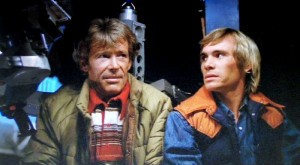The recent success of Birdman illustrates that there is a lucrative market for films about actors. Especially films about their struggle to succeed in a world that appears to devalue their work. And when it comes right down to it, their main job is to sell fantasy—which is the same thing, of course, that Hollywood does.
To borrow from Oscar Wilde, if Hollywood loves being talked about, it especially loves talking about itself. It’s not just that so many people in the trade owe their living to keeping this talk going; it’s that often criticism of how the major studios operate is muted by being internalized, then recirculated as gossip.
Not all films about actors, however, look at the subject in the same way—nor are they all successful. The first film this series will examine, The Stunt Man (1980), was ten years in the making (finally made with independent financing) and struggled to find distribution by a major studio. Even after it was nominated for three Oscars (including Best Actor and Best Director), few people ever got the chance to see it. Perhaps Hollywood did not exactly warm to the film’s refusal to use filmmaking as an excuse for escapism, as The Stunt Man reminds us of how it is shaped by the pressures of historical conflict, especially the traumatic experiences of Vietnam. Yet at the same time, the reality the film sets out to capture appears ever more dream-like, fractured, and disturbing.
The Stunt Man often strikes a note of cold, masculine reason. Perhaps the toughest moment in the film (which has more than its fair share) is when the screenwriter speaks about the absurd lengths he once went to in order to go to bed with a virgin. He was invariably disappointed, of course. The point he tries to make is that our fantasies about what we want can never live up to the reality of what we get. Which, he reminds us, is what keeps the Hollywood dream factory going.
But this tough-guy pose that the film puts on is just that: a pose, an act. If the testing of male survival is no longer on the battlefield, but the filming of a battlefield, what is being suggested is that, even as The Stunt Man imitates the action-adventure narrative being filmed, levels of reality become appearances—it goes all the way down.
On all levels, it is about acting. A young man, Cameron, who is a Vietnam veteran fleeing the law, ends up on the set of a WW I film and is involved in the accidental death of a stunt man. The director, Eli Cross, cons Cameron into taking the stunt man’s place. Cameron is forced to carry out a series of ever more dangerous stunts, until the last stunt, a duplication of the one that resulted in the original stunt man’s death. He wonders if his own fate has been sealed in a similar way.
But we can never be sure of what we are seeing, or what is even being filmed. We watch Cameron dangling on an airplane wing in midair in a heart-racing moment; then the camera pulls back to reveal that the airplane is a model a few feet off the ground being suspended by wires. The stunts are unpredictable, as Cameron is often unaware of how the performance will end, so his reactions will appear more lifelike on film.
Roger Ebert griped that the film doesn’t play by its own rules. That of course extends the theme of exploitation further: into our own heads. The film is, overall, dazzling as it spins trippy variations on actor as existentialist anti-hero. Yet it is far from style over substance: its theme hits hard—a riff on the Freudian concept that traumatic experiences must be repeated until they are worked through psychically. The Vietnam War, as The Stunt Man suggests, haunts individual minds as well as the collective nation. 
The film hones its self-consciousness into a knife-edged irony, refusing to make it safer or more comfortable by simplifying the motives of those involved. All are culpable and thus more real to us because they do not realize their culpability. Eli is both a megalomaniac and an idealist, trying to pull off what Francois Truffaut famously said could not be done: make a successful anti-war film. He will do whatever it takes. He pushes performances ever closer to the brink of death, plays head games with Cameron to probe his feelings of being in a war, and humiliates Nina Franklin, his leading lady (with whom he is in a relationship), to get her to project a more intense feeling of anguish in her performance. We never find out the true nature of Cameron’s crime; it could be monstrous. Nina pretends to fall in love with Cameron, following Eli’s orders, and she is completely committed to every role she plays. In her eyes, we see the passion for what she does, even if seems crazed—like Cameron and Eli.
While everyone during a film shoot feels the pressures of budget and deadline, it is the actors who are expected to, in some ways, not be themselves while the camera’s rolling. The fantasy being sold is transmuted through their bodies. Because they come the closet to direct exposure, they are especially liable to feel torn between living in worlds of appearance and reality.
All of the actors, in different ways, enact this duality. As Eli, Peter O’ Toole, seems already in character from the start: after reading the script, he reportedly telephoned Richard Rush, the director of The Stunt Man, and said he would kill him if he didn’t get the part. He plays his character as a misguided seeker of truth, bottling up his rage and frustration from suffering the limits of being human. Steve Railsback, who plays Cameron, never lets up on expressing the brutishness of his character, snarling his words like a trapped and frightened animal. Allen Garfield plays the role of the screenwriter with the brooding sadness of being locked into a masochistic relationship with Eli to pay the bills. Arguably the bravest role is taken by Barbara Hershey who plays Nina with a sharp sense of self-doubt as her concerns that she won’t be able to satisfy the demands of either lover dissolve a stable sense of who she really is.
Much more could be written about the filming of the stunts and how they break so many of the traditional rules of Hollywood filmmaking, but the most powerful scene is Cameron and Nina together the night before what might be his last performance. He is filled with rage, trashing the prop room, while trying to explain to her his past. He tells a story that seems ridiculous at first, but is expressed with so much raw emotion that we’re never sure if it’s not true. The mood keeps flipping from tragedy to comedy. As observer to this, Nina keys our response; her outbursts of laughter make the scene uncomfortable, as we somehow suspect she will keep to her agenda, while she shows a heartfelt compassion that might just be part of her finest acting in the film.
Scenes like these keep us in the moment, making us, like Cameron, ever more susceptible to the film’s seductive reach. At times, we feel like Eli, who is often shot from on top of a camera crane, above it all, able to take it all in, while forgetting that we still have a restricted perspective. The film cautions us about the dangers of forgetting that we can’t—always—see what we can’t see.
Cameron will go on acting out his trauma, perhaps indefinitely. Limited perspective plays a key role here. Likewise, we seem to have failed to work through the issues of Vietnam, making the same mistakes in the Middle East (next stop: Iraq?). Through Eli’s damaged vision is expressed a lament for what we have, and what we have failed to, become.

